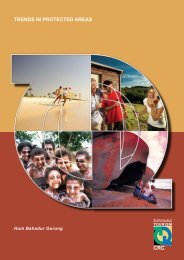icolls - Sustainable Tourism CRC
icolls - Sustainable Tourism CRC
icolls - Sustainable Tourism CRC
You also want an ePaper? Increase the reach of your titles
YUMPU automatically turns print PDFs into web optimized ePapers that Google loves.
ECOLOGY, THREATS AND MANAGEMENT OPTIONS FOR SMALL ESTUARIES AND ICOLLS<br />
owing to internal nutrient cycling and resuspension processes within the waterbody (Berelson, Heggie,<br />
Longmore, Kilgore, Nicholson & Skyring 1998; Rozan et al. 2002; Tappin 2002; Soto-Jimenez, Paez-Osuna &<br />
Bojorquez-Leyva 2003; Tengberg, Almroth & Hall 2003).<br />
Threatening Process 5: Coastal Development and Habitat Loss – Implications for<br />
Conservation<br />
ICOLLs can play a vital role in species conservation through the provision of habitat and resources for rare and<br />
endangered species (Kearney, Andrew & West 1996; Zann 2000; Roy et al. 2001; Bilton, Paula & Bishop 2002).<br />
In fact, the unique hydrological and geomorphological characteristics of ICOLLs ensure that they provide an<br />
array of unique aquatic habitats (Arthington et al. 1986; Roy et al. 2001; Bunn & Arthington 2002). For the<br />
Oxleyan Pygmy Perch (Nannoperca oxleyana) and the Honey Blue Eye (Pseudomugil mellis), endangered fish<br />
species found only in ICOLLs and coastal streams in northern New South Wales and southern Queensland<br />
(Arthington & Marshall 1999; Hughes et al. 1999; Pusey, Kennard & Arthington 2004), the conservation of<br />
these habitats is central to their survival.<br />
Since fish extraction, excessive nutrient inputs and artificial opening and closing of ICOLLs can threaten<br />
water quality, habitat complexity and food resource availability, habitat specialists like the Oxleyan Pygmy<br />
Perch might be threatened by excessive urban and agricultural development within ICOLL catchments.<br />
Fortunately, numerous National Parks and reserves have been established in southern Queensland and northern<br />
New South Wales to ensure coastal habitat essential to survival of this and other habitat specialists is not lost.<br />
However, in areas where coastal development threatens the ecological integrity of local streams and ICOLLs,<br />
rare and restricted species are likely to be adversely affected (Hughes et al. 1999; Pusey, Kennard & Arthington<br />
2004).<br />
In addition to resident estuarine and marine species that breed in ICOLLs, some of the more freshwaterdominated<br />
and infrequently opened systems are home to geographically restricted acid frog species and several<br />
restricted and endemic aquatic invertebrates (Bayly 1964; Arthington et al. 1986). The persistence of such<br />
species is dependent upon maintenance of freshwater habitats of low salinity and in consequence, ICOLL biota<br />
are vulnerable to the loss or reduction of freshwater inflows and alterations to the seasonal timing of flows<br />
(Pusey, Kennard & Arthington 2004).<br />
Flow management in the form of restrictions on water abstraction and limits or bans on the construction of<br />
barriers to movement of biota are minimal strategies to protect freshwater inflows to ICOLLs. In those<br />
circumstances where natural inflows have already been modified by land use, barriers and water abstraction, an<br />
environmental water allocation (environmental flow) strategy will be needed (Adams et al. 2002; Estevez 2002;<br />
Montagna et al. 2002; Peirson et al. 2002).<br />
Conservation of genetic diversity enhanced through ICOLL conservation<br />
From a population genetics perspective, ICOLLs are characterised by physical and physiological barriers to<br />
dispersal, ensuring that populations in neighbouring systems may be genetically distinct (Bilton, Paula & Bishop<br />
2002). As a result these systems can represent significant sites for allopatric speciation, owing to patterns of<br />
genetic drift and variable selection pressures between neighbouring estuaries. Bilton, Paula and Bishop (2002)<br />
showed that macrotidal estuaries can also operate in this manner, but given the dispersal barriers of the entrance<br />
berm in ICOLLs, population mixing for less mobile species is unlikely (Neira & Potter 1992; Bell, Cowley &<br />
Whitfield 2001; Cowley & Whitfield 2001; Cowley, Whitfield & Bell 2001; Strydom, Whitfield & Paterson<br />
2002; Viljoen & Cyrus 2002). ICOLLs are potentially very important systems for the maintenance and<br />
enhancement of genetic diversity for estuarine-resident and marine species (Hughes et al. 1999; Zann 2000;<br />
Watts & Johnson 2004). As such, changes to the duration and extent of freshwater flows and hydrological<br />
characteristics, either through patterns of water allocation (environmental flows) or forced opening of ICOLL<br />
mouths, may strongly influence the conservation status of species within these systems.<br />
Exotic and invasive species<br />
The influence of human activities on the spread of exotic organisms throughout the world’s aquatic ecosystems<br />
is of great concern (Kriwoken & Hedge 2000). In ICOLLs, changes in hydrology, particularly through extended<br />
periods of tidal flushing, may enable ‘invasion’ by large marine predatory fish species as well as by exotic<br />
organisms spread in bilge pumps (Kriwoken & Hedge 2000). These marine invaders may have lasting effects on<br />
the community structure in small ICOLLs, both through competitive and consumptive processes (Vander<br />
Zanden, Casselman & Rasmussen 1999; Kriwoken & Hedge 2000; Benoit, Johannsson, Warner, Sprules &<br />
Rudstam 2002; Stachowicz, Fried, Osman & Whitlatch 2002). In light of these effects on community<br />
12











